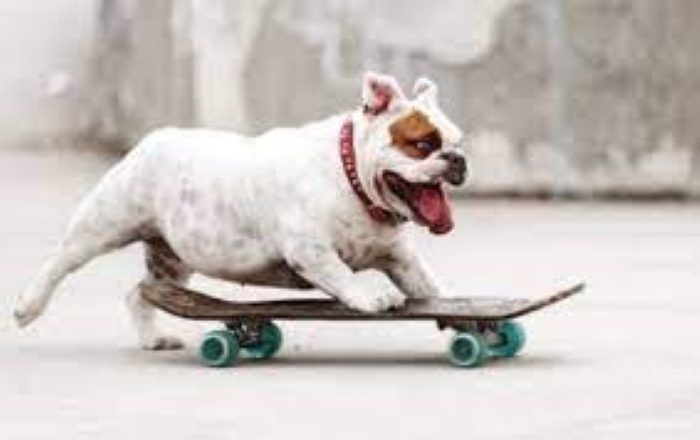Teaching your dog to skateboard can be a fun way to bond and get them exercising. With some patience and positive reinforcement, most dogs can learn this cool trick. Skateboarding is also great mental stimulation and helps strengthen your dog’s core and balance. In this article we talk about How to Teach a Dog to Skateboard in 7 steps.
This guide will take you through a step-by-step process to teach your dog to skateboard in 7 easy-to-follow steps. We’ll cover everything from choosing the right skateboard and safety gear to techniques for getting them comfortable balancing and steering their board. With regular short practice sessions, your dog will be shredding ramps and cruising streets in no time!
Table of Contents
Step 1: Get the Right Gear

To start, you’ll need to invest in a quality skateboard designed specifically for dogs. Make sure it has plenty of grip tape on top for traction and a wide enough deck they can stand on comfortably. It should also have soft rubber wheels that provide control without jolting sensitive paws.
In addition to the board, a dog helmet and pads are essential safety precautions, protecting their head and joints if they were to fall. Neoprene booties can also help avoid scraped paws.
Go with your dog when selecting gear so you can allow them to sniff out what they like best. The right size and fit will make them feel more secure learning their new skill.
Step 2: Familiarize in a Controlled Space
Once you’ve got the gear, start getting your dog accustomed to the skateboard in a safe, controlled environment free of distractions. This could be gently placing it on the floor indoors and rewarding them with treats for showing interest.
You want all experiences with the skateboard to be positive, so go slowly allowing them to approach and step on and off at their own pace. If they seem wary, don’t force anything. Patience is key.
As they get comfortable, you can hold the board steady placing their front paws up while praising and giving treats. Practice this in short sessions a few minutes at a time over several weeks until they eagerly step onto the board.
Step 3: Teach Steering
Before attempting any movement, dogs need to learn how leaning side-to-side can steer the skateboard. With the board on a carpet or grass, entice them to stand on it by holding a treat to one side just out of reach. When they lean to get it, the board will tilt in that direction.
Repeat leading them left and right for a minute or two per session. Say steering commands like “turn left” and “right” as they follow the treats. This starts conditioning them to understand shifting their weight steers the board.
Step 4: Roll Slowly on Flat Ground
Once your dog has mastered balancing and steering basics, it’s time to start rolling the board. Begin indoors on hard, flat floors free of obstacles. Gently push the board a few inches at a time, keeping it steady as your dog stands on top.
Go slow, allowing them to step on and off as needed. Keep the sessions under 5 minutes and take breaks as necessary if they seem nervous. Have treats and toys on hand to make it fun and reinforce when they stand on the moving board.
Over time, begin rolling longer distances while giving steering commands. Praise highly when they respond correctly, turning the board left or right through their weight distribution. They’ll start to pick up speed and get the feel for riding.
Step 5: Add Gentle Slopes
After succeeding on flat floors, take the training outside and start on gentle grassy slopes. Small hills help dogs learn how to balance as gravity picks up speed. Plus grass provides a soft landing surface.
Use a long leash secured to their harness for control as you walk behind the board down the slope. Reward intermittently for staying centered on the deck. If they begin veering off or look unsure, gently steer them straight using the leash, paired with a “turn” command.
Start on the most subtle incline possible, building up height gradually over multiple sessions based on their confidence. These early speed lessons get them prepped for harder rides.
Step 6: Practice Tricks
Once your dog is fully comfortable riding, steering and stopping their skateboard, you can start teaching fun tricks!
Begin working on basic commands like sit, lie down, spin and stay first on solid ground. When those are mastered, add the board. Move it under them as they perform the trick, marking and treating.
Over many short sessions, phase out luring with hand signals and treats, so they respond to verbal cues alone while skateboarding. Simple voice commands will eventually have them showing off impressive skills as they cruise parks and streets!
Step 7: Safety First!
While learning new skateboarding feats is exhilarating, it’s critical to minimize risks. Even skilled dog skaters can encounter surprises like speed wobbles, debris on paths or passerby pets that distract and cause accidents.
So make safety the top priority during all training sessions and free riding. Teach a solid “whoa” or “off” command for stopping. And stick to controlled areas away from traffic and other hazards. No amount of fun is worth an injury!
Following these tips at your dog’s pace gets them shredding properly in no time. But like any sport, skills require ongoing practice. So set up mini-sessions to keep their training sharp. And both of you be sure to wear all protective gear, every ride.
With patience, care and lots of praise through the process, skateboarding with your dog builds an awesome bond. Before you know it, you’ll have a totally rad canine athlete to cruise the neighborhood with!
Conclusion
Skateboarding is a rewarding activity to train your dog once they have conditioning and coordination basics down. By moving through seven clear steps—getting gear, building comfort, teaching steering, adding speed, practicing on slopes, learning tricks and prioritizing safety—you’ll have your dog zipping along a board like a pro.
Just remember, go at their pace, keep training sessions short and fun, and never push too far too fast. Consistent, incremental practice with positive reinforcement allows skills to develop while avoiding overwhelm or injury.
So get your dog their first board, gear up, and hit the skate park scene together! They’ll be a four-legged Tony Hawk in no time. I sincerely hope you find this “How to Teach a Dog to Skateboard in 7 steps?” article helpful.
🔗 More SuhDog Resources

Dr. Amanda Davis is the lead writer for SuhDog.com and holds a Master’s degree in Animal Behavior. With over 8 years of experience, she specializes in canine behavior and training. Dr. Davis is a trusted voice in the pet care community, contributing to various pet magazines and speaking at industry conferences. Follow her on Instagram: @suh_dog_.

